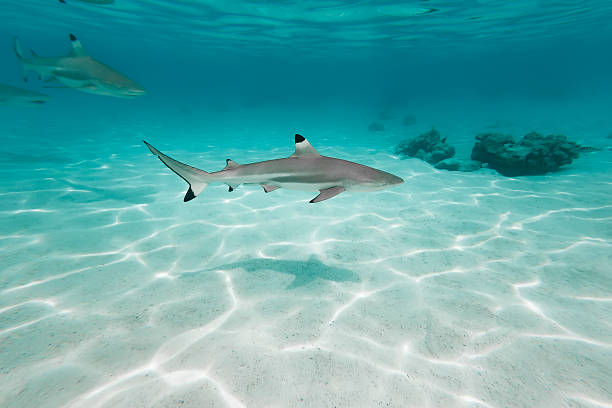
The Great Lakes are the world’s largest group of freshwater lakes. They contain about 20% of the Earth’s surface fresh water and cover an area of more than 94,000 square miles. There is a common misconception that sharks do not live in the Great Lakes because there is no salt water for them to inhabit. But surprisingly, there have been reports from anglers of seeing great white sharks in Lake Ontario and other species such as shortfin mako and porbeagle shark populations. Let’s get a better understanding and see if this is even possible.
Is It Possible Sharks Are Living in The Great Lakes?
There is not enough evidence to suggest sharks are living in the Great Lakes. While there have been many sightings, they are still considered unconfirmed reports of great white sharks or other deep-sea species that happened to swim too close to the surface.
It is possible that sharks could live in the Great Lakes if conditions were right. But doing so would require an abundance of food sources, warmer water temperatures, and an environment free of threats.
This would mean that sharks living in the Great Lakes would rely on Great Lakes species for food, which is unlikely due to their different diets. For example, the porbeagle shark preys on mackerel, herring, and other fish species, while great white sharks prey on sea lions, dolphins, other sharks, and other forms of sea life.
Sharks in Saltwater vs. Freshwater

Because the water in the Great Lakes is fresh, sharks cannot survive there. Sharks are also unable to be born in freshwater because they depend on saltwater for their development.
The difference between saltwater and freshwater is that one has salt while the other does not, which changes its viscosity or thickness. The lack of salt makes it hard for sharks to swim in freshwater because their bodies are made for saltwater. Their blood picks up the excess salt through osmosis, but this process is ineffective when there is no extra salt.
Water Temperature
Great Lakes water is generally colder than ocean water. This is because the water in the Great Lakes comes from snowfall and ice, whereas oceans are warmer. After all, they have direct exposure to sunlight. Sharks have a very narrow range of operating temperatures. They cannot survive in an environment where the temperature dips below 10 degrees Celsius or 50 degrees Fahrenheit, which means sharks can’t live in the Great Lakes.
Distance from the Equator
The Great Lakes are located far from the equator. As a result, their temperatures are not as warm as those of oceans throughout the year. While there have been cases of sharks being caught in the northern regions of North America, these were likely released due to cold shock or injuries from being seen. In warmer climates such as the tropics, sharks can travel hundreds of miles a day. This makes it plausible that great white sharks may have traveled to the Great Lakes from the Atlantic Ocean or the Pacific Ocean through the Arctic and Pacific oceans.
FAQ
Are There Sharks in Lake Superior?
There are no sharks in Lake Superior. While there have been unconfirmed reports of great white sharks in the lake, these are likely to be false sightings because it is unlikely that a great white shark could swim over 1,000 miles south through the Great Lakes and survive in freshwater.
Are There Sharks in Lake Michigan?

Lake Michigan has not had any confirmed reports of sharks living within its depths. However, one fisherman caught what he claimed was a four-foot-long mako shark off the coast of St. Joseph, which may signify that small species can make the journey to Lake Michigan from ocean waters.
Are There Sharks in Lake Huron?
No known cases confirm whether or not sharks live in Lake Huron. The only evidence is an unconfirmed sighting of two grey sharks near Alpena, which was later revealed as the first-ever recording of great white sharks.
Are There Sharks in Lake Erie?

Lake Erie has not had any confirmed reports on whether or not sharks are living within its depths. However, a fisherman caught a hammerhead shark off of Shores Corner of Ohio, which may signify that small species can journey to Lake Erie from ocean waters. Further research about this discovery is needed to affirm the results. It is possible more deep-sea fish had made it into the lake before but were released due to cold shock.
Are There Sharks in Lake Ontario?

There are no known cases confirming whether or not sharks live in Lake Ontario. The only evidence is an unconfirmed sighting of a six-foot-long, 300-pound mako shark at the north end of the lake by Western New York, which was later revealed as the first-ever recording of great white sharks.
How Else Could Sharks Get to the Lakes?
There are several viable explanations for how sharks could make it into the Great Lakes, aside from the geographic obstacles previously mentioned. First is an unintended journey through the Welland Canal that connects Lake Erie and Lake Ontario. Smaller species such as spiny dogfish or porbeagle might be able to survive this trip, but great white sharks probably won’t because they cannot stay in freshwater for more than a few days before their blood chemistry changes and they die. Obtaining exact data on the travel rate of these fish would answer this question with certainty.
Another explanation is that ballast water illegally released aquarium great whites were carried to inland reservoirs along with many other non-native aquatic organisms such as zebra mussels and Asian carp. However, this raises the question: why have there not been any sightings of great whites in other inland lakes close to the ocean?
Another explanation is that discarded fish or marine animal parts that fisherman caught were placed into reservoirs for unknown reasons. This would explain how sharks may have found their way into inland waters, but it fails to answer why they did not make their presence known until recently. It is also possible some aquariums released or escaped their specimens into the Great Lakes or adjacent waterways decades ago, and they survived.
What Are the Chances of a Shark Attack in the Great Lakes?
It is doubtful for a shark attack to occur in one of these freshwater bodies because there are no confirmed cases of great whites anywhere in the Great Lakes.
They may have been present in some of these reservoirs for many years, but if they were not seen until recently, then that is good evidence that they may pose little to no threat at all.
There would be no reason for a great white even to consider such a long and arduous journey unless food was abundant enough on the coastlines to support their high metabolism, which is unlikely due to the limited number of pinnipeds (seals and sea lions) found along the shores.
Although there has never been a confirmed case, some fishermen and boaters claim to have spotted sharks out on the water. Many of these reports are likely false because it is unlikely that a shark could swim over 1,000 miles south from the Atlantic Ocean to one of the Great Lakes, especially without being noticed by coastal residents or fishermen. Furthermore, sharks are generally wary around humans and typically stay away from areas that are heavily populated.
What Are the Chances That We Will See Sharks in the Great Lakes?
It is possible but extremely unlikely for a great white shark to make it into an inland lake like Lake Ontario because they cannot survive freshwater for more than a few days at best.
However, smaller deep-sea fish such as spiny dogfish or porbeagle may be able to survive if introduced because they have been recorded going upstream in Canadian rivers and lakes before.
It is also possible for aquarium specimens to escape their tanks accidentally through broken glass or overfilled tanks, but this would mean that there are exotic fish inside all of the Great Lakes. However, given that there have been no recorded attacks by sharks against people anywhere in the world outside of the oceans, it is very unlikely for a shark attack to occur anywhere close to shore.
Sightings of large sharks are also possible because they are excellent swimmers and may be able to cross over 1,000 miles without much trouble. These fish could be cruising along these lakeshores near deep canyons where their main prey items (seals) live. However, if they do show themselves then it will most likely be an isolated incident because great white sharks do not travel in packs as dolphins or porpoises do. It is also possible for them to appear in isolated areas if fishermen or boaters do not report them for fear that they will be fined.





